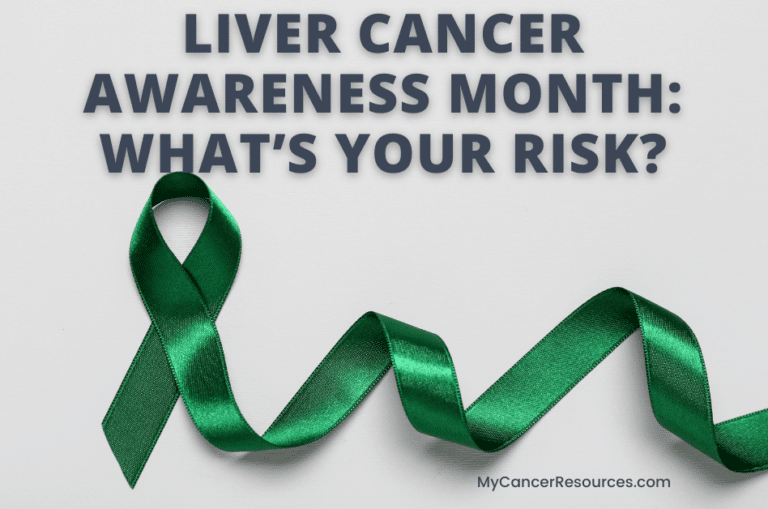
October is Liver Cancer Awareness Month, so in this article, we’ll talk about the important role the liver plays in your body, the most common types of liver cancer and their risk factors.
Understanding the Liver
The liver is one of the largest organs in your body. It is located in the upper right part of your abdomen, and carries out more than 500 functions.
Some of the most important functions include:
- Detoxification: The liver is the body’s natural detoxifier. It filters harmful toxins and waste products from your blood.
- Metabolism: The liver regulates your metabolism, helping maintain your energy levels and overall health.
- Protein Production: The liver produces important proteins like albumin, which maintains the right amount of fluid and clotting factors in your blood.
- Storage: It stores nutrients, like glycogen (a form of sugar) and vitamins, for when your body needs them.
- Bile Production: The liver produces bile, which is necessary to digest and absorb fats.
The liver can be considered the ultimate multitasker. It takes in nutrients from the food you eat and processes them to provide energy and nutrients to the rest of your body.
At the same time, the liver removes waste and toxins, preventing them from harming you.
One of the most incredible features of the liver is its ability to regenerate. If part of your liver is damaged or removed due to injury or surgery, the remaining liver tissue can regrow and return to its normal function.
The ability to regenerate is what gives hope to many facing liver issues, including cancer.
Liver Cancer: A Worldwide Burden
Here are some quick statistics about liver cancer:
- Liver cancer is one of the leading cancer-related deaths in 46 countries worldwide. (In the U.S., it’s the 5th most common cause of cancer death for men, and the seventh for women.)
- Liver cancer has a higher prevalence in certain regions of the world, including Southeast Asia and sub-Saharan Africa. In some countries, it is the most common type of cancer.
- Since 1980, the incidence of liver cancer has more than tripled.
- In the United States, it is estimated that 41,210 adults will be diagnosed with a form of liver cancer in 2023.
- Liver cancer can affect people of all ages, but is most common in those over the age of 50.
- Men are almost three times more likely to be diagnosed with liver cancer than women.
- Liver cancer rates are higher in certain ethnic groups. Native American, Alaska Natives and Pacific Islanders all have much higher rates than non-Hispanic whites in the United States.
- This journal article estimates that new cases and deaths from liver cancer can increase by more than 55% by 2040.
- Liver cancer is closely linked to several risk factors, which will be discussed later in this article.
Early Detection Is Crucial
Early detection is very important when it comes to liver cancer. Many new liver cancer cases aren’t diagnosed until the cancer is in advanced stages, because early stages rarely show symptoms.
I’ve not personally worked with anyone with early-stage liver cancer, but that doesn’t mean that it can’t be detected early and treated.
Detecting liver cancer in its early stages greatly increases the chances of successful treatment and long-term survival rates. Routine medical check-ups, especially if you’re at a higher risk, can play an important role in catching hepatic cancer before it advances.
Types of Liver Cancer
There are several types of liver cancer, but the two most common primary types are hepatocellular carcinoma (HCC) and intrahepatic cholangiocarcinoma. Let’s explore each in more detail.
Hepatocellular Carcinoma (HCC)
Hepatocellular carcinoma, often referred to as HCC, is the most common type of primary liver cancer. It starts in the hepatocytes, which are the main type of cells within the liver.
Risk Factors: HCC is frequently associated with chronic liver diseases, including cirrhosis caused by alcohol abuse, hepatitis B, hepatitis C, and nonalcoholic fatty liver disease (NAFLD).
Symptoms: In the early stages, HCC often shows no symptoms. As it progresses, symptoms may include abdominal pain, weight loss, jaundice, and a feeling of fullness in the upper abdomen.
Intrahepatic Cholangiocarcinoma
Intrahepatic cholangiocarcinoma, also known as ICC or intrahepatic bile duct cancer starts in the bile ducts within the liver. Here’s what you should know about ICC:
Risk Factors: Chronic inflammation of the bile ducts, known as primary sclerosing cholangitis, and infection with liver flukes (parasites) are risk factors for ICC. Liver flukes are parasites found in the fresh waters of Southeast Asia. These parasites can enter the body through eating raw or undercooked fish. ICC is also linked to cirrhosis.
Symptoms: Similar to HCC, early-stage ICC may not present symptoms. When symptoms do appear, they can include abdominal pain, jaundice, itching, and unexplained weight loss.
Common Risk Factors for Liver Cancer
Certain risk factors can increase your chances of developing this disease. Understanding these risk factors is the first step in taking preventive measures to protect your liver health.
Non-Alcoholic Fatty Liver Disease (NAFLD)
NAFLD is a condition where excess fat accumulates in the liver of people who consume little to no alcohol. It is often associated with obesity, high blood sugar, high cholesterol, and high blood pressure.
Over time, NAFLD can lead to inflammation and scarring of the liver (cirrhosis), which increases the risk of liver cancer. NAFLD is one of the fastest-growing risk factors for liver cancer worldwide.
Chronic Viral Hepatitis B and C
Hepatitis B
Chronic hepatitis B infection from the hepatitis B virus (HBV) can lead to liver cancer. It is a major risk factor, which is why the Hepatitis B vaccination is commonly recommended as a preventative measure. Hepatitis B can be contracted through unprotected sex, sharing needles or syringes, or from an infected mother to baby at birth.
Hepatitis C
Chronic infection with the hepatitis C virus (HCV) is another leading cause of liver cancer. Hepatitis C can be contracted through contact with blood from an infected person.
Processes for screening blood samples have improved so much that developing hepatitis C through blood transfusions is rare. Nowadays, most cases of hepatitis C infections are from sharing needles, though in some areas of the world, medical equipment that is not sterilized properly can contribute to the spread of this disease.
Advances in hepatitis c treatment, including antiviral therapies have made it possible to cure HCV, reducing the risk of developing liver cancer.
Excessive Alcohol Consumption
Long-term and excessive alcohol intake can lead to alcoholic liver disease and cirrhosis, which causes liver damage and also greatly increases the risk of liver cancer.
To reduce this risk, it’s important to limit alcohol intake.
Smoking
Smoking has been associated with an increased risk of liver cancer. The harmful substances in tobacco can damage liver cells and contribute to cancer development.
Obesity
Obesity is closely linked to an increased risk of liver cancer. People with obesity are more likely to develop non-alcoholic fatty liver disease (NAFLD), which can progress to liver cancer.
Maintaining a healthy weight through a balanced diet and regular exercise is an important step in reducing your risk.
Other Risk Factors for Liver Cancer
Cirrhosis
Cirrhosis of the liver, often caused by chronic alcohol use or viral hepatitis, is a significant risk factor. The risk is increased even more if cirrhosis is combined with other risk factors.
Aflatoxins
Eating foods contaminated with aflatoxins, which are naturally-occurring toxins produced by certain fungi molds found on agricultural crops like corn, peanuts, cottonseed and tree nuts, is linked to an increased risk of liver cancer.
Diabetes
People with diabetes have a higher risk of developing liver cancer, especially if the diabetes is poorly controlled.
Knowing your risk for developing liver cancer can help you take steps to improve your overall health. If you are at risk, work with health care providers to get screened in hopes that should you have liver cancer, and early diagnosis will help give you the most treatment options to choose from and the best chances of eliminating the cancer cells.
Conclusion
The liver plays a very important role in your body, and many lifestyle factors can contribute to the development of liver cancer.
Being aware of these factors can help you lower the risk of developing liver cancer. If you are at higher risk, you can work with your medical providers to screen earlier, which can give you more treatment options and increase your chances of survival.
If you or your loved one have liver cancer, remember that you are not alone. In addition to your oncologist and their support teams, I am here to help you understand your type of cancer, treatment options and side effects, deal with side effects of the treatment plan you choose, and address the different mental, emotional, financial and spiritual ways that cancer affects your life.
We can work together to help you not just survive, but to thrive. Reach out to me today for more information on how we can work together.



